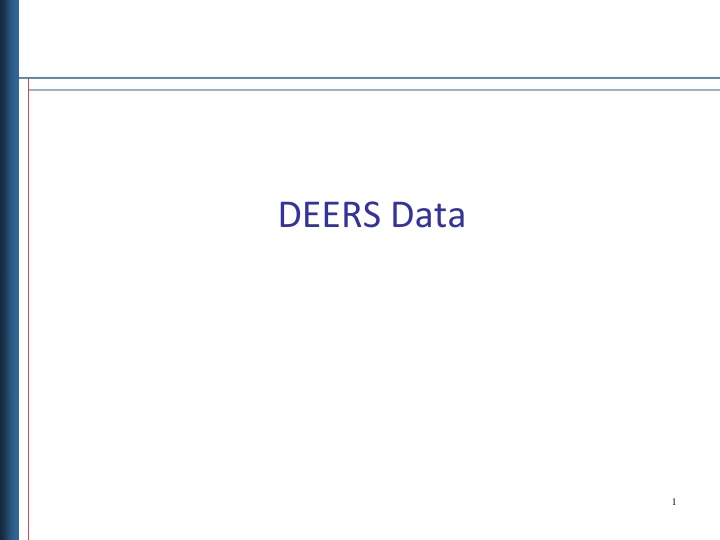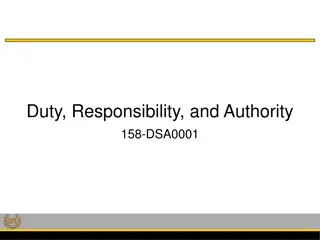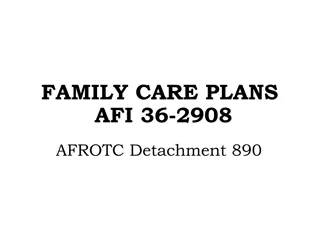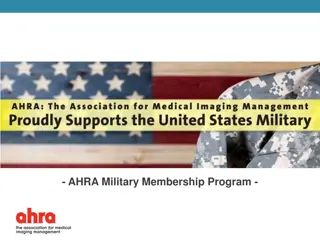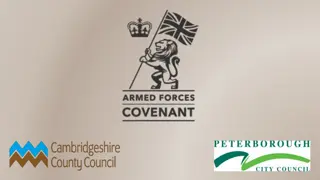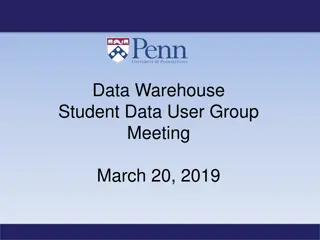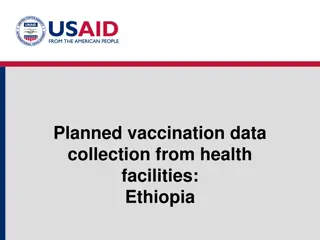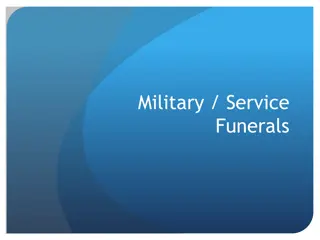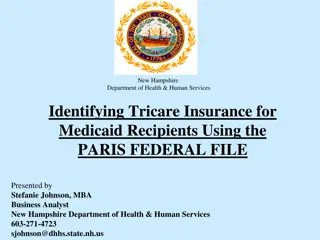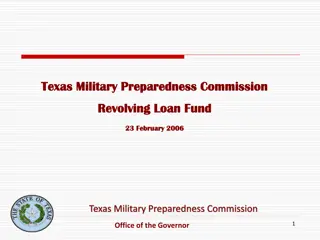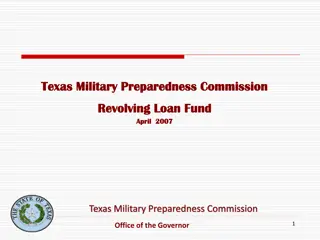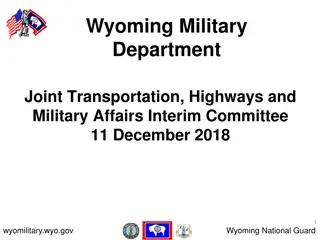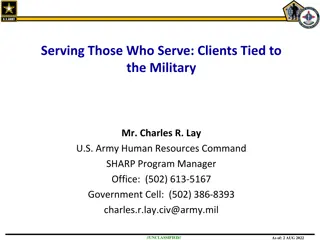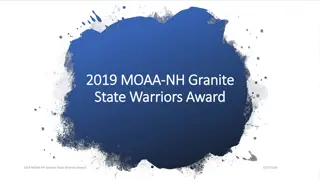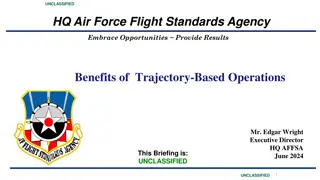Managing and Proliferating DEERS Data in the Military Health System
This content discusses the management and proliferation of DEERS data within the Military Health System (MHS). It covers how DEERS data are maintained, who is included in the data, data upkeep processes, strengths and weaknesses, data proliferation throughout the MHS, added value of MDR processing, key data elements for DaVINCI, uses for data elements, trends in DEERS data, and more.
Download Presentation

Please find below an Image/Link to download the presentation.
The content on the website is provided AS IS for your information and personal use only. It may not be sold, licensed, or shared on other websites without obtaining consent from the author.If you encounter any issues during the download, it is possible that the publisher has removed the file from their server.
You are allowed to download the files provided on this website for personal or commercial use, subject to the condition that they are used lawfully. All files are the property of their respective owners.
The content on the website is provided AS IS for your information and personal use only. It may not be sold, licensed, or shared on other websites without obtaining consent from the author.
E N D
Presentation Transcript
Objectives Describe how DEERS data are maintained and proliferated. Describe who is in the DEERS data and how they got there Discuss the data upkeep process Identify strengths and weaknesses with DEERS data. Describe how DEERS data proliferate throughout the MHS Identify added value of MDR processing and available DEERS based data products. Identify which data records come to DaVINCI Identify and discuss uses for key data elements provided to DaVINCI. Identify data elements that are easily available from the MHS but have not been provided. Discuss current trends in DEERS data 2
DEERS Data Management and Proliferation 3
Data Management DEERS uses operational systems to manage information about DEERS uses operational systems to manage information about MHS benefits. MHS benefits. Enables real-time updates from around the world so that those who do DEERS Checks have accurate information Who s in DEERS? How did they get there? Who s in DEERS? How did they get there? Sponsors are added to DEERS by the Services. This is thought to be a reliable source of information. Sponsors add family members at RAPIDS (Real-Time Automated Personnel Identification Systems) Locations worldwide. Documentation such as marriage or birth certificates are required. Once in DEERS, information can be updated a number of ways. 4
Data Management Once in DEERS, how is a person s DEERS data kept up to date? Once in DEERS, how is a person s DEERS data kept up to date? The Services continue to provide updates to DEERS; including changes in rank, address, occupation, guard/reserve status, etc. Sponsors and beneficiaries can update information through a Beneficiary Web Interface or by going to be a RAPIDS center. CMS provides DEERS information about Medicare eligibility. TRICARE Managed Care Support Contractors and an Other Health Insurance (OHI) discovery project provide information about other private healthcare insurance. Social security provides information about deaths. Etc.. Etc.. 5
Data Management The MHS accesses DEERS data in several ways: The MHS accesses DEERS data in several ways: Through a real Through a real- -time interface for viewing current status (General Inquiry time interface for viewing current status (General Inquiry to DEERS to DEERS or GIQD) or GIQD) From MHS systems that downloaded data from DEERS during a DEERS From MHS systems that downloaded data from DEERS during a DEERS check. check. Through a monthly point in time extract sent to the MHS Data Repository Through a monthly point in time extract sent to the MHS Data Repository (MDR). (MDR). By subscribing to web By subscribing to web- -services updates services updates Through the application of a longitudinal DEERS file to healthcare records Through the application of a longitudinal DEERS file to healthcare records to correct known errors from the sources. to correct known errors from the sources. Through the initiation of a DRS request Through the initiation of a DRS request help desk query help desk query *RAPIDS=Real Time Automated Personnel Identity System 6
DEERS Data Proliferation If Jane Smith has a medical appointment on 3/1/2018, DEERS is checked so that her access can be determined. The check is initiated by the MTF when the appointment is made. DEERS will respond by updating the MTF s CHCS patient and enrollment files. Only the MTF requesting the DEERS check is updated. Another DEERS check is done automatically right before the appointment. When the MTF submits an encounter record, when all goes right, the demographic information is current, up to date from the DEERS check. Info in DEERS Beneficiary ID Beneficiary Name Sponsor ID Sponsor Name Relationship to Sponsor DOB Gender Health Plan Health Plan Start Date Health Plan Stop Date 1234567890 Jane Smith 2345678901 John Smith Spouse 12/31/1985 Female TRICARE Prime 1/1/2018 12/31/2017 Beneficiary ID 1234567890 Enc Date 3/1/2018 MTF Tripler Health Plan Prime Diagnosis Diabetes 7
MDR DEERS Data The MDR receives the VM-6 data feed from DMDC on the 1st of each month. Point in time snapshot with start/stop dates for many attributes. Changes that are contained wholly within a month are not reflected in the data file. Numerous field combinations and complex logic are required to generate even basic information. Can include more than one record per person, if a person has more than one reason for eligibility. Critical for proper identity assignment. Includes both ineligible and eligible records. De-deduplication and application of eligibility criteria is necessary to properly count and characterize patients. 9
MDR DEERS Data John and Jane are two married Active Duty Service Members They are each their own sponsors Name John Doe Jane Doe DEERS ID A B Sponsor ID A B Member Category Active Duty Active Duty Relationship Self Self Start Date 10/1/1996 6/1/2004 John retires. Now John is both a Retiree and a Dependent of Active Duty. John now has two records in DEERS. Name John Doe John Doe Jane Doe DEERS ID A A B Sponsor ID A B B Category of Patient Retired Active Duty Family Active Duty Relationship Self Spouse Self Start Date 8/1/2018 8/1/2018 6/1/2014 The MDR assigns a Primary Record Flag , which depicts the highest benefit for the patient on the 1st of the reported month. 10
MDR DEERS Data DEERS data after processing in MDR When the MHS counts eligible beneficiaries, only primary record content is counted. Name John Doe John Doe Jane Doe DEERS ID A A B Sponsor ID A B B Category of Patient Retired Active Duty Family Active Duty Relationship Self Spouse Self Start Date 8/1/2018 8/1/2018 6/1/2014 Primary Record 0 1 1 Prior to extracting data to most systems, the MDR applies a primary, eligible record condition so that users don t make mistakes and inadvertently include people in reports who are not eligible. 11
MDR DEERS Data DEERS data after processing in MDR When the MHS counts eligible beneficiaries, only primary record content is counted. Name John Doe John Doe Jane Doe DEERS ID A A B Sponsor ID A B B Category of Patient Retired Active Duty Family Active Duty Relationship Self Spouse Self Start Date 8/1/2018 8/1/2018 6/1/2014 Primary Record 0 1 1 Prior to extracting data to most systems, the MDR applies a primary, eligible record condition so that users don t make mistakes and inadvertently include people in reports who are not eligible. This was a problem with the original DaVINCI data from DoD. The DoD team did not understand DEERS data and retrieved all primary records with a retired beneficiary category. That misses people like John Doe. Has since been corrected. 12
MDR DEERS Data Assume John and Jane had children all listed under the father. Prior to John s retirement Name John Doe Jane Doe Joe Doe Janet Doe DEERS ID A B C D Sponsor ID A B A A Member Category Active Duty Active Duty Active Duty Family Active Duty Family Relationship Self Self Child Child Start Date 10/1/1996 6/1/2004 4/27/2007 3/19/2010 Being an active duty dependent is a better benefit than being a retiree benefit. Now the MDR assigns the active duty family records to be primary, rather than retiree family records. Name John Doe John Doe Jane Doe Joe Doe Joe Doe Janet Doe Janet Doe DEERS ID A A B C C D D Sponsor ID A B B B A B A Category of Patient Retired Active Duty Family Active Duty Active Duty Family Retiree Family Active Duty Family Retiree Family Relationship Self Spouse Self Child Child Child Child Start Date 8/1/2018 8/1/2018 6/1/2014 4/27/2007 8/1/2018 3/19/2010 3/19/2010 Primary Record 0 1 1 1 0 1 0 13
MDR DEERS Data MDR DEERS files contain records for ineligible beneficiaries also. Necessary so that potential changes in benefits can be modeled. For example, when the TRICARE Reserve Select benefited started, the DEERS data were used to gather records for those ineligible guard/reserve to begin to determine how many people might enroll. The MDR uses eligibility information from the data feed to assign an MHS Eligibility Indicator. DaVINCI has only been fed primary, eligible records. Primary Record Flag Eligibility Flag 0 1 0 1 128,437 9,468,440 1,259,868 7,338,216 14
MDR DEERS Data The main MDR DEERS file is a monthly file Users can track changes to beneficiaries month to month. Retiree living in Northern California for all of FY2018 15
MDR DEERS Data The main MDR DEERS file is a monthly file Users can track changes to beneficiaries month to month. Active Duty Family Member Switching to Retiree Family Member 16
MDR DEERS Data The main MDR DEERS file is a monthly file Users can track changes to beneficiaries month to month. Inactive Guard who was called up in May 2018 (FM 8) Had TRICARE Reserve Select prior to call-up (because there were inactive guard records for more than the 30 day early alert period 17
Update Process When DEERS data are processed, the previous 6 months of data are also updated. This is necessary because DEERS data are not complete when initially provided. Newborns don t need to put in DEERS for 60 days, so DEERS does not know always know of their existence for a few months. Deaths are also not immediately reported to DEERS and so the deceased need to be removed from the files once the proper documentation of death has been provided. Retroactive changes in enrollments, beneficiary category and other attributes also occur. The most current DEERS months are not complete. It takes several months for DEERS data to settle down. 18
Update Process When DEERS data are processed, the previous 6 months of data are also updated. This is necessary because DEERS data are not complete when initially provided. Newborns don t need to put in DEERS for 60 days, so DEERS does not know always know of their existence for a few months. Deaths are also not immediately reported to DEERS and so the deceased need to be removed from the files once the proper documentation of death has been provided. Retroactive changes in enrollments, beneficiary category and other attributes also occur. The most current DEERS months are not complete. It takes several months for DEERS data to settle down. DoD did not provide the updated data to DaVINCI. There are known dead people in the monthly source files provided 19
Person Identifiers Beneficiary ID and Sponsor ID Typically contains an SSN ID type code discerns the content. DEERS Electronic Data Interchange Person Number (EDIPN) Each individual registered in DEERS is assigned an EDIPN. This is the best way to identify a DoD beneficiary. One per person, unless there is a smoosh Beneficiary Name Date of Birth DaVINCI has a linking table that maps the EDIPN to the VA Patient ICN. 21
Demographic Variables Age Gender Marital Status Race and Race/Ethnicity: These variables are of low quality and not generally used by DoD. Geography: Zip Code: Includes APO and FPO for overseas patients who have them. Country Code: For those overseas beneficiaries who have APOs or FPOs, the country code is the US even if the beneficiary is overseas. For those that don t have an APO or FPO, this will represent the country where the beneficiary lives. Catchment, PRISM and MTF Service area represent circles around MTFs with various radii and rules used to assign beneficiaries in overlapping areas, such as DC. 22
Service Related Variables Sponsor Status Coded on both sponsor and dependent records. 23
Service Related Variables Sponsor Service and Sponsor Service Aggregate Navy vs Navy Afloat 24
Beneficiary Category Beneficiary Category and Ben Cat Common 25
Beneficiary Category Beneficiary Category by Bencat Common 26
Health Plan Information Much of the available information on healthcare coverage is not being provided by DoD. Data fields that are provided to VA include: Alternate Care Value: Legacy value indicating enrollment program. Not populated after Jan 1, 2018. Enrollment MTF: Identifier of the MTF the person s PCM is affiliated with, if enrolled in Prime or Plus at an MTF. PCM ID: Identifier of primary care manager. Contains EDIPN of the provider most of the time. 27
Available Data DoD provided a slimmed down version of the data mart feeds out of MDR to other systems. Data fields that were redacted and would be important to pursue include: Occupation Codes, so that studies can be done on people who had particular occupations in the Service. Unit Identifiers, so that studies can be done on particular units Healthcare Delivery Program Codes, so that the type of eligibility and enrollment a beneficiary has can be incorporated. Medicare Eligibility and Other Health Insurance Information, so that censoring of data can be understood Pay Plan and Pay Grade, so that studies can look at officers and enlisted separately and so that particularly vulnerable pay grades can be analyzed. Personnel Entitlement Condition, for understand guard/reserve status 29
DaVINCI Cohort DoD does not have any information about who is eligible for care in the VA so it s not possible to directly query DoD data to get dual- consumers. The DaVINCI cohort includes any patient who meets any of the following conditions: Was ever on Active Duty Was ever recorded as either Activated Guard/Reserve or Inactive Guard/Reserve Was ever recorded as Retired Is included in the VA s Master Veteran Index. Only primary, eligible records are provided to DaVINCI in each month s file. 31
Whats Going on Lately? The Active Duty and Activated Guard and Reserve populations had begun to increase. 33
Whats Going on Lately? The Inactive Guard/Reserve population is going up, too. (the last few months of data are not complete and could fill in as more time passes). 34
Whats Going on Lately? Patients can have PCMs in the MTFs, or with a civilian provider. For years, the % of enrollees with a civilian provider was growing. This was concerning to DHA, because this meant less patients for providers to practice, and less volume in which to spread overhead costs MTFs are strongly encouraged to recapture enrollees, that is, to find new people to enroll. MTFs are also actively trying to recruit TRICARE Plus enrollees. 35
